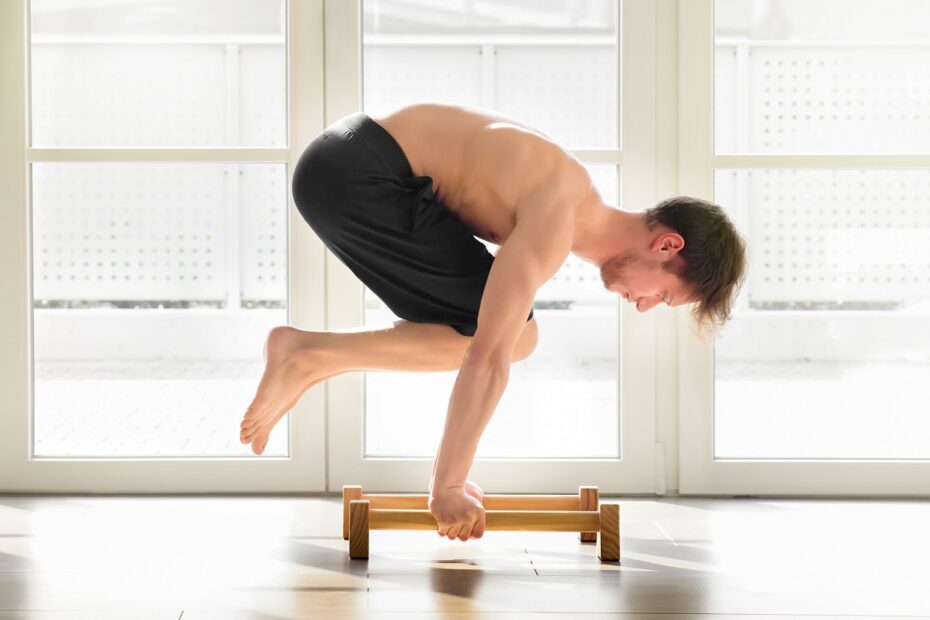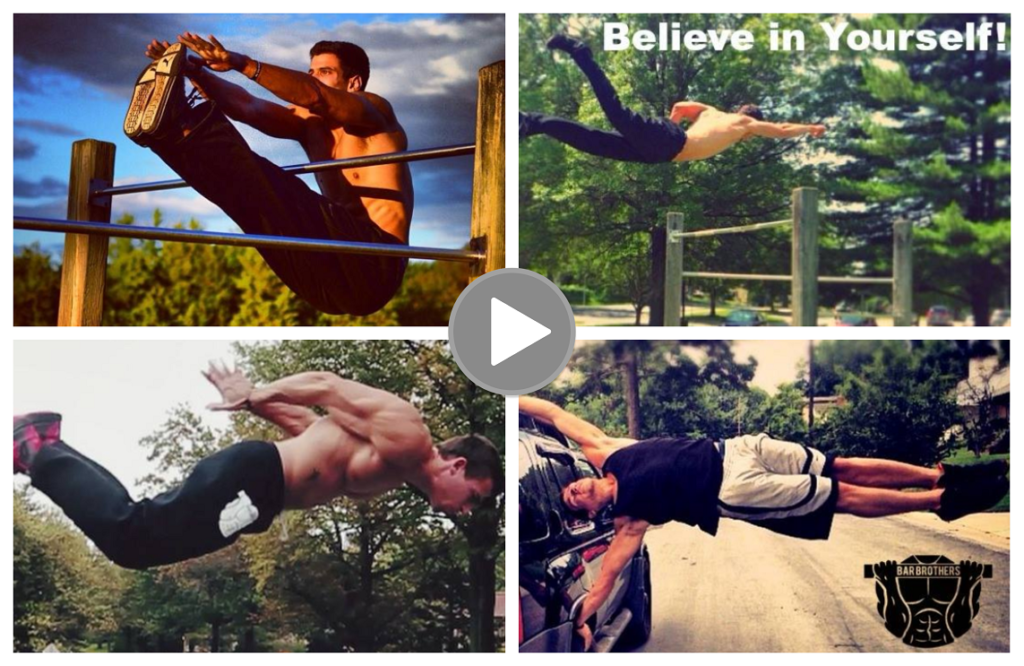Disclosure: This post contains affiliate links. Meaning if you click on a link and make a purchase, I'll earn a small commission at no extra cost to you.
True story… The first time I ever attempted a tuck planche was when I was around 20 years old.
I remember assuming the position and slowly leaning forward until I was supporting my entire bodyweight with just my hands.
Only to greet the floor seconds later with nothing but my face and the small taste of blood that soon followed.
Short story long, it was a painful experience. And it’s a memory I’d rather leave in the deepest darkest parts of my brain where it can’t hurt me anymore.
Which brings us back to reality…
Now, to most people, the tuck planche is one of many small stepping stones to being able to master the full planche.
And I’ll bet my best friends cat that most people would be willing to take a hard kick in the nuts in exchange for mastering this incredible feat of strength.
But since you’re still here, then I’m going to safely assume that you’re lost in no man’s land and need an effective solution for moving towards (and eventually beyond) the tuck planche.
So in today’s blog post, I’m going to be revealing some of the common problems most people face when executing this move. In the hope that one day soon, you’ll be able to progress towards some of the more advanced calisthenics exercises like the advanced tuck, straddle planche, and yes, even the full planche.
Oh, and just before we kick things off. If you want a program that will break down how to perform badass calisthenics skills like the muscle-up, front lever, and other exercises that defy logic.
Then I’d highly recommend checking out the Bar Brothers Program.
Basically, Bar Brothers is a 12-week program designed to help bridge the gap between the average calisthenics junkie who can barely perform a pullup without puking up a lung…
…To an insanely strong, jacked ninja who’s capable of performing exercises most people could only do in the absence of gravity.
It’s pretty awesome, and it gets my official stamp of approval.
Anyway, hit the video link below to take a look: Bar Brothers – The System
(Video Will Open In A New Window)
Table of Contents
Mistakes To Avoid When Performing A Tuck Planche
Now, this isn’t going to be your typical progression post that shows you how to go from couch potato to tuck planche master in a few short weeks.
Because to be honest, if you don’t have a basic foundation of strength to work with, you’re not going to be anywhere near ready to attempt this exercise.
If this sounds like you, I’d recommend taking a step back and checking out this beginner calisthenics workout instead.
So now we’ve got that out of the way, below I’m going to highlight 5 problems you’re probably going to face when it comes to executing a proper tuck planche.
Followed up with a few simple adjustments and fixes you can make to turn this beast of an exercise into child’s play.
Here we go…
You Can’t Hold A Tuck Planche From The Floor
Now, this is one of the more common problems when performing a tuck planche, and the reasoning behind it is very simple.
Basically, you don’t yet have the necessary core strength to hold your body away from the ground.
See, any calisthenics exercise that requires you to suspend your body off the ground is going to be made insanely difficult if you don’t have the core strength to support your body.
It’s not just the tuck planche, either.
If you’ve ever tried performing an L-sit from the floor. You probably realized that you don’t have anywhere near the core strength needed to hold yourself up for more than a few seconds.
The solution?
Maintain a higher position above the ground.
It sounds stupidly simple, I know. But performing a tuck planche on a set of parallettes or even a set of dip bars will give you a little more room for error when it comes to suspending your body off the floor.
This isn’t a permanent fix, by the way. But it’s going to allow you to practice holding a slightly easier variation of the tuck planche. Until you’ve built up the necessary core strength to be able to perform it on the floor.
Ideally, you’ll want to be able to hold a tuck for at least 20 seconds (preferably 30 seconds) on the parallel bars before moving your efforts on to the floor.

Your Hand Position Is All Wrong
The next issue I see a lot when performing the tuck planche all to do with the position of your hands.
Now, for most exercises, there isn’t really any hard and fast rule for hand positioning. And a lot of the time, you should do what feels comfortable for you.
The problem with the tuck planche, however, is that without any counter flexion from your wrists. There’s not going to be a lot stopping you from falling flat on your face (as I did) as you begin to lean forward.
So where exactly should you place your hands?
Well, the optimal position for most will be to turn the hands slightly outwards so that the thumbs are facing directly forward.
This is ideal for two reasons…
Firstly, it allows a little wiggle room for those who don’t have the required wrist flexibility to point the fingers directly forward.
And second, there is still enough tension in the wrists to counterbalance your weight, causing any unnecessary injury.
Nine times out of ten, this is going to be the perfect hand position when you’re first learning how to perform a tuck planche.
You’re Not Locking Your Elbows Out
Another problem (but not as easy to fix) is achieving full elbow lockout when attempting the tuck planche.
This is difficult, and it’s something I know countless people struggle with when it comes to maintaining form.
But the fact remains that if your elbows aren’t locked out, you’re not going to be hitting your goal anytime soon.
This is where a set of parallel bars comes in handy because, again, it’s going to allow you to work on your form without constantly scraping your feet on the floor.
So here’s what you need to do if you’re struggling with locking out the elbows…
Find yourself a set of parallel dip bars and hold yourself up with your elbows fully locked out and the pits of your elbows facing forward.
Then, slowly tuck your knees up towards your chest while hinging at the hips.
If you’re doing it correctly, it should look like this…

Now, if you look closely, you’ll notice how the feet are slightly below the top of the bar.
This is fine at first, as it’s going to allow you to practice your form until you’re capable of bringing your feet above the level of the bar.
But eventually (and with consistent practice), you’ll be able to tuck your knees high enough to be able to attempt the tuck planche from the floor.
The Position Of Your Scapula (Shoulder Blades) Is All Wrong
This is something a lot of calisthenics newbies don’t pay any attention to at all.
But it’s just as important (if not more important) as everything we’ve discussed so far.
So to give you a little more insight, the scapula (shoulder blades) can be broken down into four positions.
This includes…
- Protraction
- Retraction
- Depression
- Elevation
Here’s what each one looks like… (see image)

A mistake I see a lot of people make here is that they tend to naturally retract their scapula while attempting to hold the tuck planche.
This usually comes about due to a lack of tension in the body, which can often be caused by not locking the elbows out, as we discussed earlier.
Now, the correct way to engage your scapula is to have the shoulder blades both protracted (pulled forward) and depressed (pulled down).
Why?
Because it creates tension throughout the body. And it’s this tension that’s ultimately going to allow you to maintain position and form without your body caving in at any given moment.
To be honest, this is the one thing that’s going to bridge the gap between a good tuck planche and a great one.
So remember, protract, depress, and keep the tension throughout. And you’ll be well on your way to holding this exercise with ease.
Your Not Fully Engaging Your Core
The last mistake I see a lot is a lack of core engagement.
Now, if your elbows are locked out, and your scapula is in the right position, then you’ve nearly got it nailed.
But a lot of people still fall short by not creating the necessary tension in their midsection to cap things off.
This is the missing piece of the puzzle when it comes to holding a successful tuck planche.
Get this right. And you can officially call yourself a tuck planche sensei and start working towards more challenging variations of this exercise.
A great way to practice proper core engagement is to adopt a hollow body position.
However, this is easier said than done from a tuck planche position. So I’d recommend practicing the planche lean while adopting a hollow body to really get an idea of what it feels like when your core is fully engaged.

Quick Recap
So to quickly recap, here’s how to correctly execute the tuck planche.
- Focus on holding the tuck planche for at least 20 seconds on the parallel bars before attempting to hold it directly on the floor.
- Your hands should be slightly turned out to avoid overstraining the wrist. But at the same time, allow enough counter flexion to a hold position without faceplanting the floor.
- The elbows should be fully locked out with the pits of the elbows facing forward.
- Your scapula should be fully protracted and depressed to maintain tension throughout the body.
- The core needs to be fully engaged. The abs should be braced, but you should still be able to breathe normally.
Moving Beyond The Tuck Planche
If you practice this move consistently. I have no doubt that eventually, you’ll be able to move beyond this exercise and start taking your calisthenics skills to an entirely new level.
Remember, the tuck planche is only the beginning. And with hard work, there’s no reason you shouldn’t be able to get close to a full planche as long as you put the work in.
Now, this is only the tip of the iceberg when it comes to planche training.
And if you’re deadly serious about progressing your skillset and learning gravity-defying exercises that only a small fraction of hardcore calisthenics junkies can master…
…Then I’d recommend checking out the Bar Brothers Program and seeing if it’s a good fit for your training goals.
Now, I’m not going to lie and tell you that this program is for everyone. Because the truth is that most people reading this won’t be ready for what’s in store for them on the other side.
But if you’re hell-bent on getting in the best shape of your life and want a PROVEN program that’s going to kick your ass. Then this is exactly what you’ve been looking for.
Anyway…
If you’re just a tad curious about how this program works, and you want all the juicy details on how it can help you build an insanely strong functional body…
…Hit the video link below to learn more about what it can do for you: Bar Brothers – The System
(Video Will Open In A New Window)
Any questions or comments? Feel free to drop them in the comments section below

